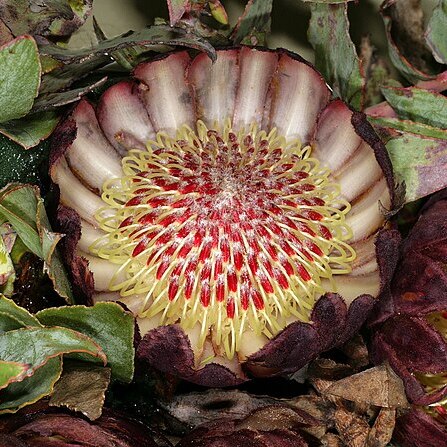A low sprawling shrub with a single short main stem to 30 mm in diam. from which radiate looping to horizontally spreading stems forming a low mat up to 1.25 m in diam., and up to 400 mm in height. Stems glabrous, glaucous, 1-3 mm in diam., the leaves decreasing in size towards the apices of each stem. Leaves arising at right angles to stem, cordate-elliptic, usually strongly cordate, 30-80 mm long, 15-50 mm wide, apex acute, base amplexicaul, auriculate; surface dull green to very heavily glaucous. Inflorescences spherical in bud, opening to shallowly crateriform, 60-80 mm in diam.; axillary, in the axils of the lowermost leaves on each stem. Involucral receptacle conic-depressed, 20-25 mm wide, 5-10 mm high. Involucral bracts 4-5 seriate, very densely covered with a thickly velutinous to tomentose, purple-black indumentum, rubbing off in patches; outer series imbricate, ovate-acute 10 mm wide, 10-15 mm long; inner series loosely spaced, slightly incurved, oblong-spathulate, 45-50 mm long, 8-15 mm wide, apices rounded, margins densely ciliate with a thick, purple-black indumentum. Perianth 25-28 mm long, very strongly adaxially arcuate; tube and sheath region inflated, prominently quadrangular, glabrous 15-18 mm long, 6-7 mm wide; limbs narrowly elliptic, deflected adaxially, glabrous but apices acutely to acuminately crinite, with brownish trichomes. Anthers 4, linear, 5 mm long, sessile. Style very strongly adaxially arcuate, curved at right angles, 25-30 mm long, tapering terminally. Pollen presenter linear-acute, 5-7 mm long, prominently grooved. Ovary obovoid 5 mm long, covered with 10-12 mm long, straight tawny trichomes. Hypogynous scales subulate to lanceolate, 2 mm long. Flowering times are also influenced by locality and microclimate but in general the main flowering flush takes place during July and August with lowland races opening as early as June and highland races persisting into September.
More
Sprawling, grey-green shrublet to 40 cm. Leaves spreading, ovate and clasping at base. Flower heads axillary, borne near base of branches, cup-shaped, 60-80 mm diam., involucral bracts oblanceolate, ivory, chocolate-velvety beneath, style 25-30 mm long.


